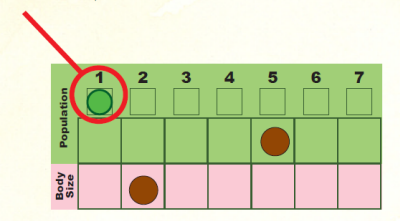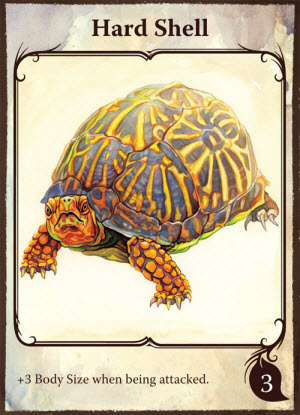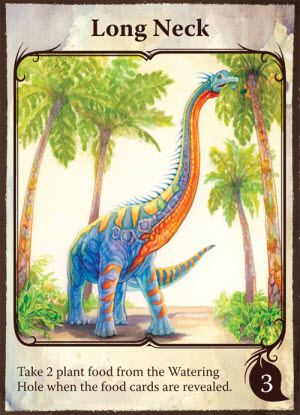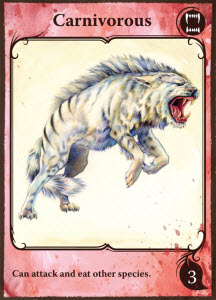Whether it’s gliding through the air or tracking prey through darkness, scaling sheer cliffs or hiding in plain sight, animals can do some pretty impressive things. Nature has directed each and every species that has ever walked the Earth through a cycle of developing and enhancing their survival abilities. That process isn’t quick, or easy, and there a lot of mistakes along the way. (We’re looking at you Platypus.) Which species thrive and which go extinct are at the heart of the race for continued existence.

????
This is the central idea behind the aptly-named game of Evolution, which is itself evolved from an earlier iteration of a game with the same title. In this thematic card game, players take up the mantle of nature’s guiding hand as they seek to make their individual species prosper as much as possible.
Evolution begins around a proverbial Watering Hole, whereby each player starts the game as a burgeoning new species to the landscape. Each species in the game has two statistics: Population and Body Size, and every new creature starts out with a rank of 1 in each. Population represents how many of your scaly, slimy, and /or hairy critters there are running around, while Body Size advertises how large the creature is compared to those around them.
Each round, players draw a number of cards equal to three plus the number of creatures they have in their territory. Every card corresponds to different animal Traits that are available in the game, such as having a long neck or the ability to burrow. Cards like these:
Trait cards also have a Food number, which is a randomized value that aids in the production of your habitat’s food production. After drawing cards, each player discards one card face down to the Watering Hole.
Then, players take turns using as many of their Trait cards as they see fit. In the spirit of Evolution’s theme of adaptability, Trait cards can be utilized in three ways:
- They may be added to any species you have in play. Each species can have up to three different Traits, in any sort of strange, befuddling or even eerie combinations. (Seriously, how’d you like dealing with something the size of a Buffalo burrowing underground?) If a species already has three Traits on it, an existing one must be discarded first.
- They may be discarded to create a new species in your play area.
- They may be discarded to increase a species’ Population or Body Size by one.
After each player utilizes all of the cards they wish to, those cards discarded to the Watering Hole are revealed, and the sum of the Food amount is added to it. Now, it’s time to feast upon all of the delicious flora lying about! Players take turns allocating one Food at a time to a critter they control. Players continue doing this until each species they have has enough Food on it equal to its Population size, or until Food runs out.

One food is added to this species board.
Prototype Shown
Sinking Your Teeth In
As is the case in the actual world, though, not everything survives on plants. Some creatures crave something a little…meatier. Yes, one such Trait a creature can gain is to become a Carnivore. Carnivorous creatures don’t feed from the Food bank. Instead, they go on the hunt. For a Carnivore to feed, it must attack another species, and that species must be of a smaller Body Size than it. When a Carnivore feeds, it gains Food equal to the other creature’s Body Size, and the creature’s Population who just became a tasty snack drops by one. If a Population ever drops to zero, that creature goes extinct, never to be seen again.
Carnivores can attack your own species for food or they can go after another player, creating a moderately combative component to the game. Much like everything else in nature, though, there are plenty of Traits that can protect a creature from attack. Of course, there are also Traits to overcome those protections and…well, you get the idea.
After feeding is done, players set aside all Food cubes they gained during the round. If a creature didn’t receive enough to cover all of its Population, however, the Population drops to the amount that did get fed. You know, because you let the rest starve.
Then a new round begins. At the end of the game – when the deck runs out – players tally up their Traits, Populations, and stored Foods. The highest point value becomes the winner, boasting that they are truly the best at adapting to their environment.
Scoping Out The Ecosystem
One of the most impressive aspects of Evolution is how well it blends the theme and mechanics of creature adaptation. Players could just as equally compete as a herd of sauropods all scrambling for large Food grabs or as a throng of hyenas all scavenging each other’s territories, and both of them are viable gameplay options.
Indeed, Carnivores add in their own weight to the game, as they give players the very real sense of high risk and high reward as you compete for food. The back and forth between Carnivores and their prey is especially interesting as it changes the dynamic of the game each round. Do you go after another player simply for a bite to eat, or to prevent them from getting points? Moreover, the penultimate rule of survival – that every species needs to feed to continue on – is a wonderful choice for the game’s win condition.
Regardless of the strategic path you take, Evolution makes for a game that is quick, simple, and entertaining. It has a distinctive Euro-style feel to it but it isn’t a game you’re going to be lost in the wilderness trying to grasp. Dare we say that it’s pretty…instinctual?
(Sorry.)
Nevertheless, if you think you have the skills to come out on top in a fight for survival of the fittest, then be sure to swoop, gallop or swing over to Evolution’s Kickstarter.
[sc:Preview-Sealer ]Photo Credits: Platypus by Livescience.



